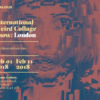Please, introduce yourself and tell us a little bit about you.
My name is Matthew Robertson and I’m a visual artist from San Francisco. I grew up in a creative household with a handful of older siblings who kindly began introducing me at a young age to an eclectic assortment of artists, musicians, writers and filmmakers. This exposure to good and interesting art was counterbalanced by a great deal of time spent in front of the TV absorbing 80’s programming, playing video games and eating sugary cereal. I work primarily with oil but I’m happy to use any medium that will leave a mark. Often my oil paintings will incorporate some combination of acrylic, pastel, crayon and charcoal.
You are a painter, but this particular set of paintings embrace collage in a unique way. How does collage influenced you? How did you arrive to paint collages?
I’ve arrived at creating collage like paintings in kind of a round about way. Storytelling has always interested me and my paintings tend to involve some sort of narrative component. William Burroughs’ use of the cut-up technique in his phantasmagoric masterpiece ‘Cities of the Red Night’ has played an important role in the development of my recent work. By dismantling his sentences and rearranging them in a nonlinear fashion Burroughs creates a prose that is profoundly abstract as well as curiously accurate in its representation of moment-to-moment thought. My recent paintings have taken on a collage like quality as the result of exploring how to employ a visual analog of the cut-up technique in my work.
When collage becomes a way of representing things more than a technique, how would you define collage in your approach to art?
I think that the collagist is similar in many ways to the poet. Both are frequently dealing with spatial restrictions and tend to employ the tools of abbreviation, symbolism and abstraction to successfully communicate ideas within their self-imposed constraints. The collagist will often distill the narrative components of their work down to their essential states, which in turn magnifies the value of the object. Then, by truncating the visual elements and juxtaposing them in unexpected or incongruous ways the collagist can transform the meaning of the objects and venture into the realm of abstraction and symbol. I’m interested in creating paintings that use this type of visual language to communicate my ideas.
… and why don´t you just make collages? Does the translation from collage to painting add any conceptual meaning to your work?
I wouldn’t say that choosing to make collage like paintings versus working specifically with collage is the result of a decision to express myself conceptually, but rather I think that it comes down to the fact that I began painting first and grew to love working with the medium. The mechanics of the process of painting are really enjoyable to me and I feel that there will always be room for me to grow and expand my practice within the craft. I also tend to work on sizable surfaces and I think that the medium of paint is a practical approach to creating images of larger dimensions.
Love your definition of collage as poetry. How would you define the work of a painter making painted collages…?
In regards to my more recent paintings I think of them as a type of optical poem, at least that’s what I’m intending to create. The collagist’s approach to image making allows me to more easily abstract the narrative component of my paintings which can infuse the work with a sense of mystery or ambiguity. I want to present the viewer with an enigma of sorts, an image that requires some effort to unravel and make sense of: a visual puzzle.
How do you feel collage is perceived nowadays in the contemporary art world?
As evidenced by the wide range of great work showcased on The Weird Show, I think that the medium of collage is clearly thriving in the present-day art world. Perhaps it has something to do with the ease of which the individual artist has access to history’s great library of imagery to piece together their work? I personally feel that collage is as viable a mode of expression as any other medium. If you’re alive and making art than your work by definition is contemporary regardless of whether you’re using means that have been around for thousands of years or experimenting with tools that were just thought up yesterday. Whether we’re working with collage, video, paint, performance, language, 3D printers or a combination of them all, art made today must first pass through the lens of a 21st century mind before being projected onto the landscape of the modern world. Any discipline or medium that the artist chooses to employ to express him or herself is as good as the next.
http://matthewrobertsonart.com/









